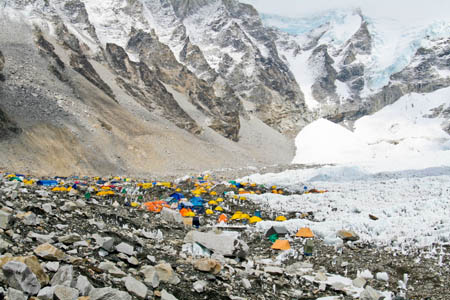
Everest base camp. Photo: Ilker Ender
Nepal’s cabinet will meet next month at Everest base camp to draw attention to the dangers posed to the mountain country by climate change.
Prime Minister Madhav Kumar Nepal will fly to Lukla with those ministers deemed physically fit enough to cope with the flight to the 2,860m (9,383ft) airport in the Khumbu valley, followed by the helicopter flight to base camp, at 5,360m (17,585 ft).
The ministers risk acute mountain sickness by making such a rapid journey from Nepal’s capital Kathmandu, which lies at a similar height to the summit of Britain’s highest mountain Ben Nevis.
The 4 December meeting will highlight the fact that Nepal’s glaciers are shrinking, leading initially to a danger of flooding to many villages and, in the long term, drought as the glaciers feed the major rivers which are the source of water for much of the country. The ice of the Himalaya contains the biggest store of frozen water outside of the polar ice caps.
Although the glaciers have been retreating for centuries, climate change has accelerated the process. In August, scientists reported that the Imja Glacier above Dengboche was retreating by about 70m a year, with a large lake forming, threatening villages down the valley with flooding if it bursts.
The cabinet meeting, called by Madhav Kumar Nepal and his Communist Party of Nepal Unified Marxist-Leninist, is timed to precede the Copenhagen climate conference.